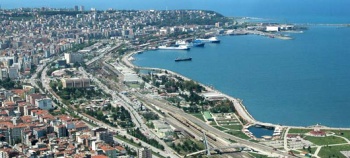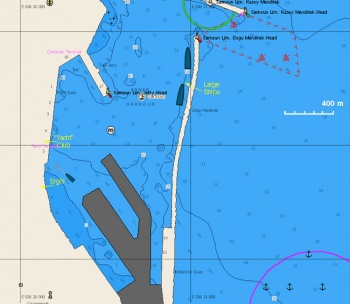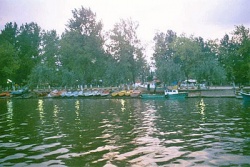Samsun
From CruisersWiki
| Samsun
| |
Samsun with a population of about 725,000 is one of the largest natural harbors on the S. Black Sea. There is a Turkish saying "Black Sea has four harbors: Samsun, Trabzon, July, and August".
Samsun, the Greek Σαμψούντα, was founded by Ionian Greek colonists from Sinop in the 6th century BC, most likely attracted by the large harbor. They named the city Amisos. In the 5th century a second wave of colonists arrived, this time from distant Athens, led by Athenocles. The Athenians changed the name of the city from Amisos to Piraeus. Although the new name did not last for very long, the city flourished by trading with the interior of Anatolia.
In the Hellenistic times Mithridates VI Eupator expanded the city and built many temples. During the Third Mithridatic War Amisos was burned to the ground by the Roman general Lucullus. Later Lucullus, regretting his action, rebuilt the city. Pharnaces, the son of Mithridates, recaptured the city from the Romans. He in turn was defeated by Julius Caesar and the city became a Roman possession again. It was after this victory that Caesar sent to the Senate in Rome the message: Veni, Vidi, Vici (I went, I saw, I conquered).
After the Romans the city changed hands many times until 863 AD when it was taken from Omar, the emir of Melitene, by the Byzantines. In 1194 it was captured by the Seljuks. At various times it was held by the Komneni of Trapezun, the Mongols, and the Genoese. In 1425 the Ottomans captured it from the Genoese who, before abandoning the city, set it on fire.
In the late 19th century the city, dominated by a large Greek population, became very prosperous by exporting tobacco directly to Europe. On May 19, 1919 Atatürk landed in Samsun and proclaimed the Kemalist movement that led to the creation of modern Turkey. Following the 1923 exchange of population treaty, after the Greek-Turkish War, all of the Greek population of Samsun along with all the other Greeks of the Turkish Black Sea were forced to migrate.
Charts
- BA
- 2214 The Euxine or Black Sea
- 2237 Inceburun to Isikli Burnu
- 1274 Samsun
- NIMA
- 55105 Eastern Part of the Black Sea
- Turkey
- 133 Yasun Burnu - Tirebolu
- 1311 Samsum
Radio Nets
Also see World Cruiser's Nets.
Local Weatherr
See Turkey.
The approaches to Samsum are straightforward.
Check-in facilities (for Customs and Immigration)
Samsum is a port of entry/exit to Turkey.
Berthing Options
Samsum Harbor
| Samsum Harbor
| |
The harbor of Samsum is large, about 1 nM deep. It is mainly a commercial harbor with enormous cranes and it is very dirty. In fact it the dirtiest harbor I have ever been in (--Istioploos 02:53, 16 December 2008 (UTC)). You will be floating in unspeakable filth and be surounded by a smell to match it. Large fish, some as long as half a meter, are constantly jumping out of the water, which has the color of dark chocolate. Yet, it is a very safe harbor.
The Black Sea Cruising Guide advises to anchor off the "Yacht Club." Said club is a small club with a few sailing dinghies. It is hard to find. It is best to find Ergin Hut who is a personage in the harbor. Ergin Bey will help you either to anchor or to use one of his moorings. He can also make arrangements to get a barrel of fuel from which you will have to siphon into jerry cans.
If you have an arrangement with Ergin Bey to watch over your boat, this is a good and safe place to leave her and explore by car the interior region.
Marinas & Yacht Clubs
None.
Anchorages
None.
Offshore Islands
None.
Yacht Repairs and Services
Marine Stores
None.
Repairs/Yards
None.
Fuel, Water, & Electricity
- Fuel
- Ergin Bey can make arrangements for a barrel of Diesel
- Water
- N/A (Not Available)
- Electricity
- N/A
Things to do Ashore
Tourism
While modern Samsun is a vibrant city with traffic and people but it is neither picturesque nor gracious. It is in fact an ugly dirty nondescript city with many stores, fishmongers, photo-copy stores, grocery stores, musical instrument stores etc. Lots of pedestrians. It is, however, a good starting place to explore the region, particularly the interior.
Amasya
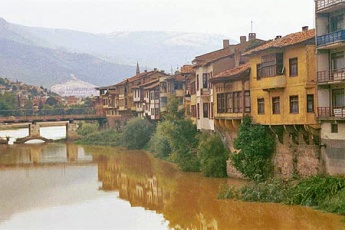 Amasya Amasya
| |
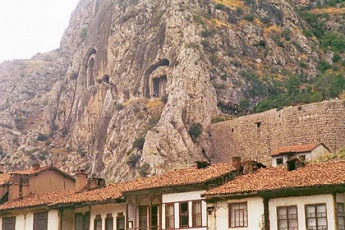 Hellenistic Tombs in Amasya Hellenistic Tombs in Amasya
| |
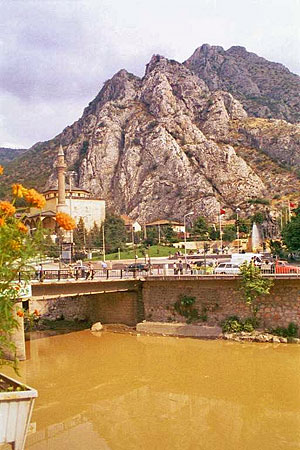 The River in Amasya The River in Amasya
| |
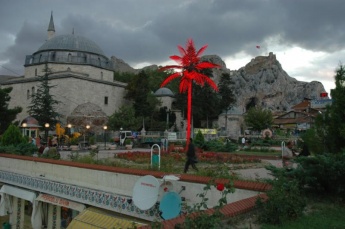 Tokat Republic Square Tokat Republic Square
|
Amasya is built along a river whose water has a yellow color. It has some lovely old houses along the banks of the river. It is surrounded by mountains with large carved tombs. Unfortunately, surrounding the charming old center of the town are the inevitable concrete apartment blocks that are so prevalent along the Turkish Black Sea. Despite these ugly buildings, the town is very attractive, in fact, it is the most attractive town we have seen so far in the Black Sea.
The first settlement in Amasya (Αμάσεια) was established on the summit of a precipitous peak which here dominates a narrow part of the river valley. It probably antedates the arrival of Alexander the Great in Asia Minor. There are about a dozen Hellenistic tombs on the cliffs of the river valley. After the death of Antigonos, Mithridates proclaimed himself king of Pontos, made Amaseia his capital, and founded a dynasty which lasted for almost 300 years. During the Third Mithridatic War Pompey captured the city and razed it to the ground. Later rebuilt under the Romans, Amaseia was a provincial capital. Strabo, the Geographer, was born c 64 BC into a distinguished local family which at first supported the Pontic king Mithridates Vl in his struggle against Rome, but which later changed sides and adopted the Roman cause. Strabo studied at Nysa and later in Rome where he lived for a number of years. He traveled from the Black Sea to Ethiopia and from Armenia to Etruria. In 24 AD he visited Egypt with his friend Aelius Gallus, the governor of that country. It seems likely that he spent some time studying mathematics and astronomy in Alexandria. Strabo wrote his Historical Memoranda, a 47-book work of which only fragments survive. His Geography in 17 books, which draws heavily on the work of earlier Greek geographers, was designed for the use of members of the government and higher civil servants. In addition to the detailed practical information, it is peppered with anecdotes and legends and describes the antiquities and customs of the lands which it covers. Strabo, whose name rather unflatteringly means "squint-eyed," died ca 21 AD.
After the arrival of Christianity Amaseia became an Episcopal see. Bishop Eulalios of Amaseia attended the Council of Nicaea in 325. The fortress of Amaseia, enlarged and strengthened by the Byzantines, fell to the Arabs in 712, but was recaptured by the Byzantines during the reign of Leo the Isaurian (717-41). The last Bagratid king of Armenia, Gagik II (1042-45), received a grant of lands from the Byzantine emperor Constantine IX in eastern Cappadocia and made Amaseia his capital. After the battle of Manzikert in 1071 the Seljuq Turks took Amaseia and renamed it Amasya.
The Danishmendid clan established a powerful emirate here. In 1133 John II Komnenos failed to capture the citadel and had to be content with pillaging the lands of the Danishmendid. Later Amasya came under the rule of Kilij Arslan and his successors. Taken by the Mongols in the 13 cetury, it became part of the possessions of the Eretnids and of Kadi Burhaneddin, the emir of Sivas. In 1392 it was taken by Beyazit I for the Ottomans. During the centuries that followed Amasya was greatly favored by several Ottoman sultans who chose to live here. They made it a center of culture and learning that was frequently compared with Baghdad. Later the town fell into a decline which was compounded by earthquake damage in the 18, 19 and 20 centuries and a disastrous fire in 1915. It has never quite recovered from these catastrophes and today seems to have accepted the role of quiet provincial capital.
Tokat
Tokat is a mountain small town. The drive to the town is full of hairpin turns and goes from lush green forest to an alpine grassland. The grass is interspersed by ugly brick factory buildings clustered around villages with equally ugly houses. On the way from Tokat to Amasya the road descends down to a valley along the Yesilirmak (the Greek Iris) to a river. The scenery now is completely different, it is arid and more Mediterranean.
Grocery & Supply Stores
Several stores in the town (not near the anchorage).
Eateries
There are many restaurants along the waterfront
Internet/WiFi
Available?
Laundry
?
Motorbike & Car Rentals
There many agencies in town but most had no cars. Sakura Cars will deliver near your yacht.
Garbage Disposal
Trash cans.
Transportation
- Busses and dolmuş to other cities
- Airplanes from Samsun airport to Istanbul and Ankara
Routes/Passages To/From
Popular passages/routes, timing, etc.
Cruiser's Friends
Contact details of "Cruiser's Friends" that can be contacted for local information or assistance.
Forum Discussions
List links to discussion threads on partnering forums. (see link for requirements)
External Links
References & Publications
Comments
We welcome users' contributions to the Wiki. Please click on Comments to view other users' comments, add your own personal experiences or recommend any changes to this page following your visit. In over 25 years of cruising I have never seen a more polluted harbor --Istioploos 20:44, 16 December 2008 (UTC).
Verified by
Date of member's last visit to Samsun and this page's details validated:
- August 1999 --Istioploos

 Travels with S/Y Thetis
Travels with S/Y Thetis
| This is a usable page of the cruising guide. However, please contribute if you can to help it grow further. Click on Comments to add your personal notes on this page or to discuss its contents. Alternatively, if you feel confident to edit the page, click on the edit tab at the top and enter your changes directly. |
| |
|---|
|
Names: Lighthouse, Istioploos |
